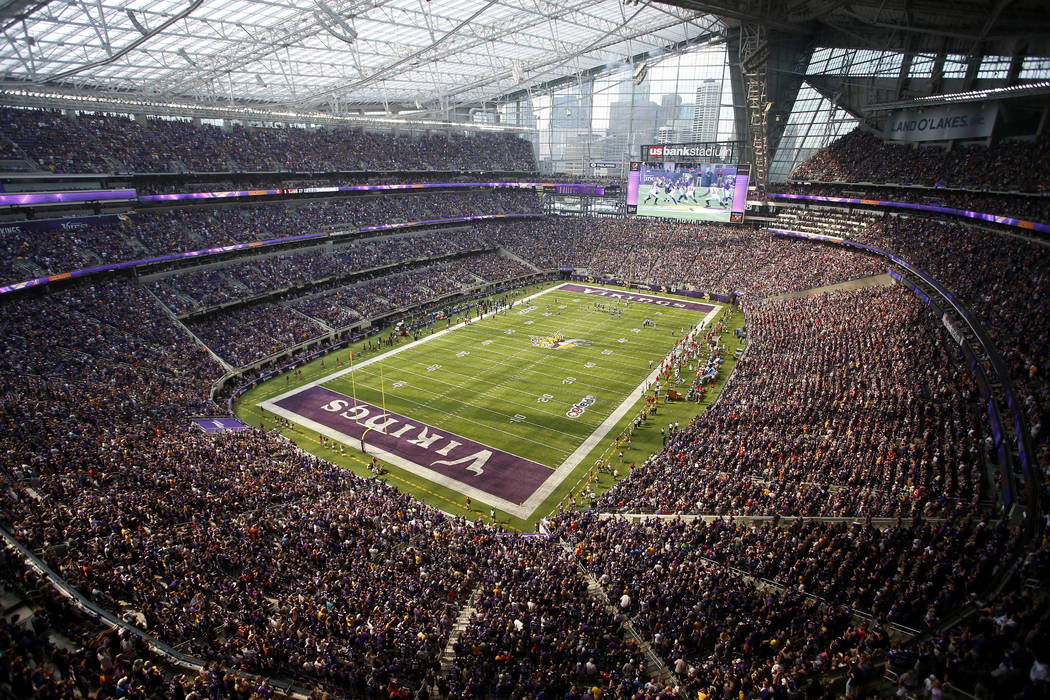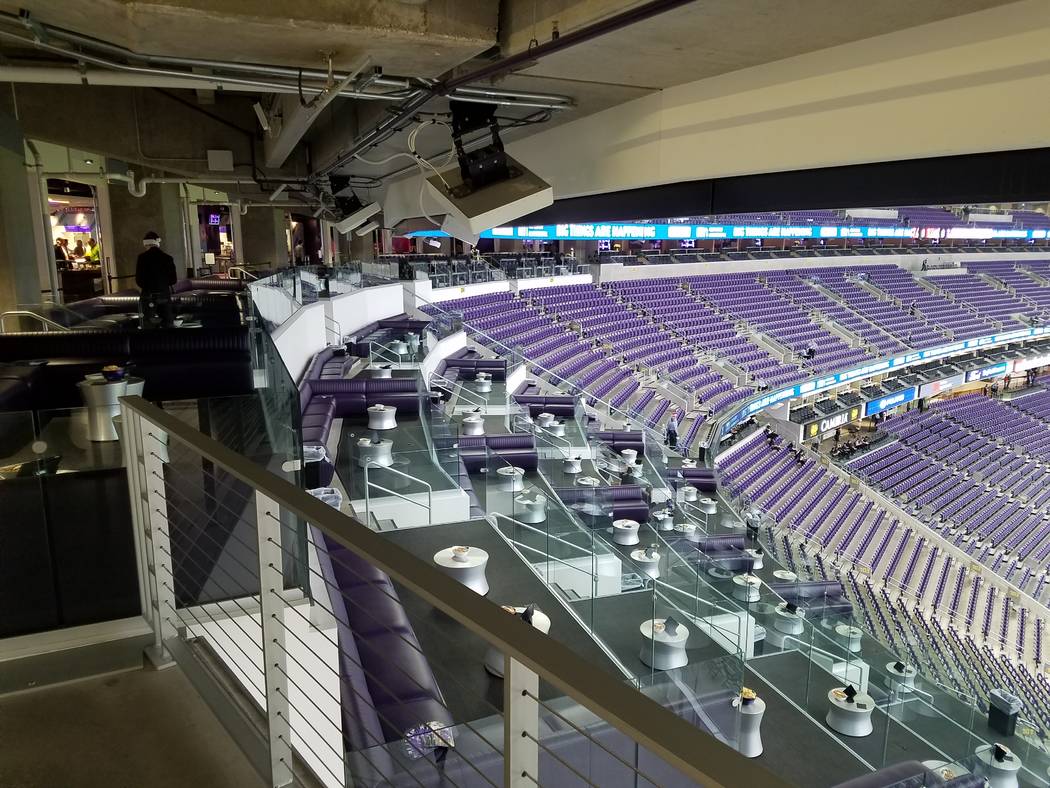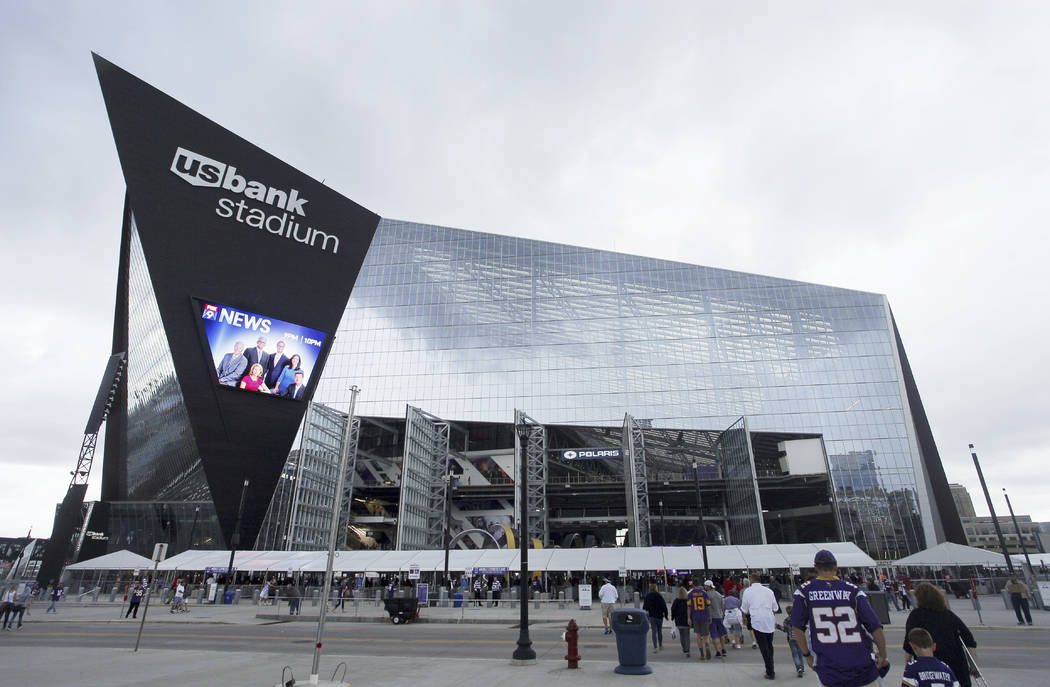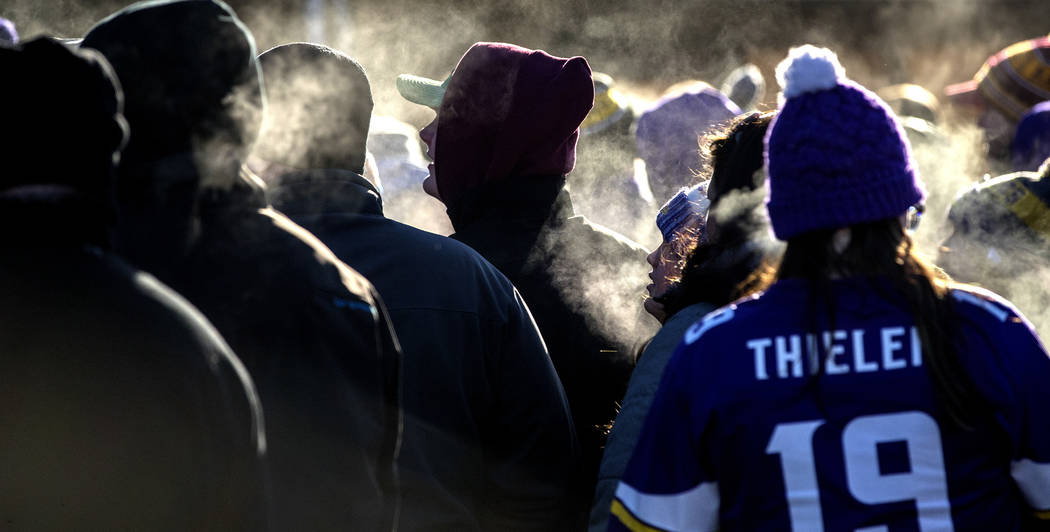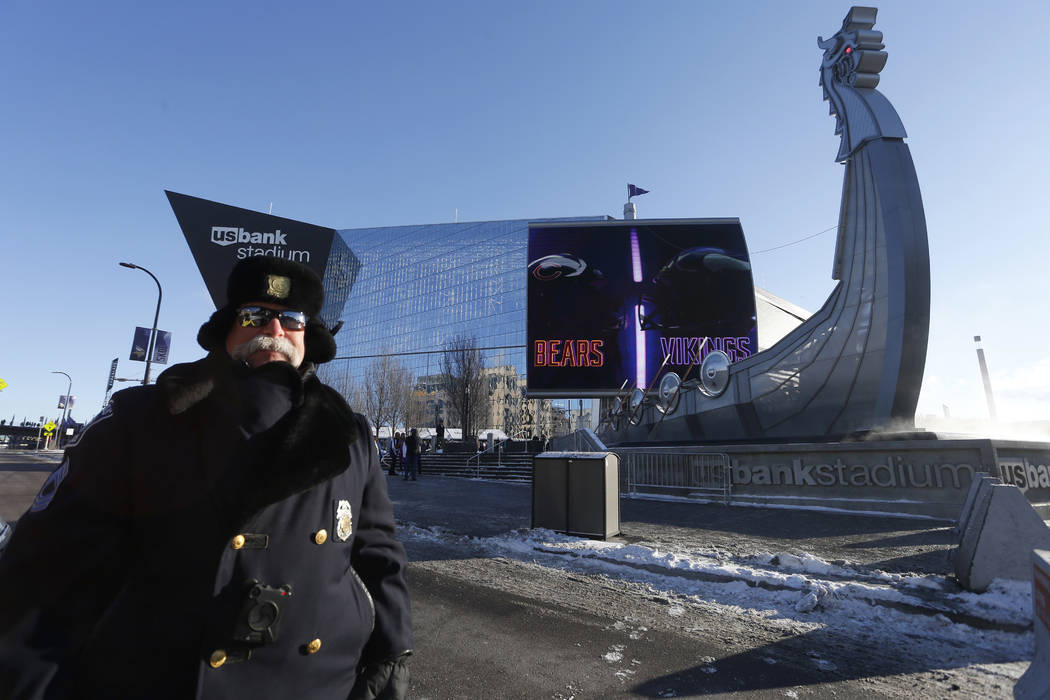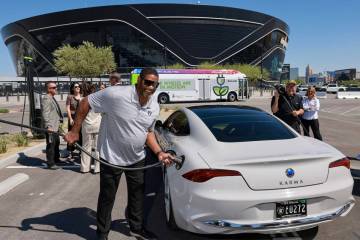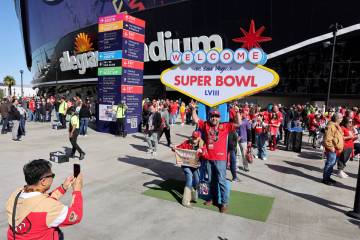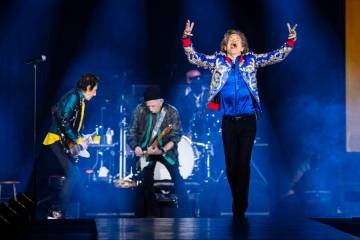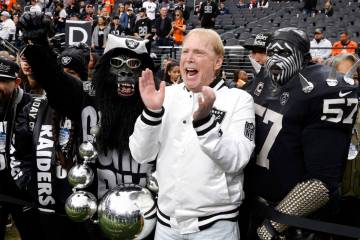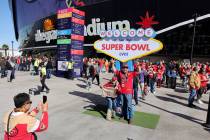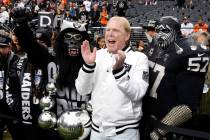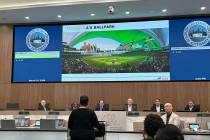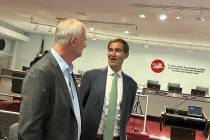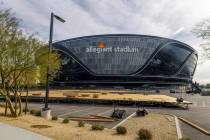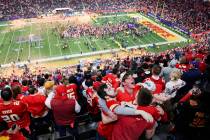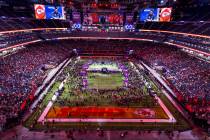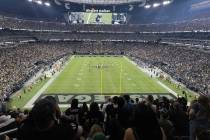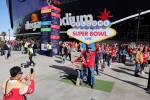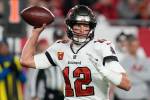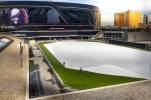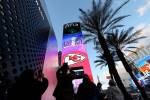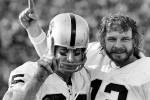Minnesota’s Super Bowl bid holds lessons for Las Vegas
Editor’s note: This is the first of several stories on how Minneapolis’ hosting of the Feb. 4 Super Bowl offers a guide for Las Vegas.
MINNEAPOLIS — Ask the average Minnesota Vikings fan about the team’s potentially historic run toward Super Bowl LII and there’s no question: They would love the team to be the first ever to host the NFL’s championship game in its home stadium on Feb. 4.
Ask a restaurateur or hotelier in Minneapolis the same question, and the answer might be a little different: It would be nice to be the first participant of 51 previous games to host despite the Vikings’ 0-4 record in past Super Bowls. But logically, crowds from out of town would be diminished if the Vikings are in it.
After all, the spectacle of the Super Bowl is a tourism opportunity that in past years has generated up to $700 million for host cities. Having the home team in the game probably would cut into that tourism economic impact projection because many fans who would participate in the run-up to game day wouldn’t go out to eat or stay in a hotel — they would just go home.
The Vikings, the No. 2 seed in the National Football Conference, are assured of at least one home game before the Super Bowl. And the team could host a second game if the top-seeded Philadelphia Eagles falter. The Eagles’ starting quarterback, Carson Wentz, was injured Dec. 10 and is out for the remainder of the season after a serious knee injury.
Jan. 14 playoff game
The Vikings will play the winner of one of two NFC wild-card games on Jan. 14 and, should the Eagles stumble in their Jan. 13 game, the Vikings could be the home team for the NFC Championship game on Jan. 21.
Such a scenario would be unprecedented and presents a series of logistical challenges for Minneapolis and the 1½-year-old U.S. Bank Stadium. The NFL usually takes over the Super Bowl stadium venue a month before the game for preparations. As it applies to Super Bowl prep time, the NFL has entered uncharted waters.
In Minnesota, there is no lack of enthusiasm for hosting the game, which Minneapolis is doing for the second time.
When the city hosted the game in the Hubert H. Humphrey Metrodome in 1992, the University of Minnesota said the 58,000 people traveling to the game spent $47 million, including $9.4 million at hotels and $6.8 million in restaurants.
Last year’s game in Houston generated an estimated $350 million.
Las Vegas Super Bowl
Hosting a Super Bowl is already being discussed in Las Vegas even before a 65,000-seat stadium is built for the soon-to-relocate Oakland Raiders.
But times have changed in Minneapolis in the 26 years since Super Bowl XXVI.
U.S. Bank Stadium, built on the exact location of the Metrodome, will have the capacity of 70,000 fans on game day. The NFL says 63,130 attended the game in 1992.
Roughly 1½ Metrodomes could fit within the confines of U.S. Bank Stadium.
“They say you don’t design the church for Easter Sunday, but we did design this building to be multipurpose, not just for monster trucks, and concerts and soccer, but also for baseball and to host the world’s grandest sporting event, the Super Bowl,” said Lester Bagley, executive vice president of public affairs for the Vikings.
Bagley is one of the biggest fans of the stadium, noting the huge homefield advantage the Vikings gain with the energy generated by fans.
He acknowledged that there are challenges on the horizon for the NFL if the Vikings succeed in their goal of getting to and winning the Super Bowl.
“No home team has ever reached the NFC Championship game or even the divisional round,” Bagley said.
“Once the NFL takes over the building, there’s a 30-day window that’s essentially blacked out. The area becomes a mini-construction project, and a lot of things change.”
Nice problem
But Bagley acknowledged that from his and the team’s perspective, it’s a nice problem to have.
Among the things that have to change are the capacity, and the designers of U.S. Bank Stadium anticipated the need for additional seats well before the stadium doors opened. Instead of bolting seats into concrete, they were placed on rails. When capacity needs to expand, the space between seats is tightened by an inch or two. Squeezing seats together allows room for additional seats. Multiply that by the hundreds of rows of seats in the building and the capacity can move from 66,200 to 70,000.
Bagley explained that the NFL once had a policy that any host stadium needed a minimum 72,000 seats, but that has been revised and U.S. Bank Stadium is suitable as a host venue.
Another change that will occur will be converting one of the club areas within the stadium to a press area. Bagley said the Vikings already have received 5,800 media requests for the game.
Lesson for Las Vegas
The Vikings first initiated efforts to host the Super Bowl, which is approved by a vote of team owners, while the stadium was under construction.
“This is a lesson for Las Vegas for the Super Bowl,” Bagley said. “The Raiders and Mr. (Raiders team owner Mark) Davis need to lobby the other owners. First, you need to put a credible package together. And then we went to the NFL owners to get the votes to support it.”
“When it came down to the day to vote, New Orleans was the favorite — they had bid on 10 and won 10,” Bagley said. “Now, they’re 10 for 11, because we secured it.”
Once the Vikings secured the bid in 2014, Minnesota Gov. Mark Dayton appointed a Super Bowl committee because hosting the event was viewed as a statewide project. Multiple layers of organization were built within the host committee, which began ramping up plans in 2015.
A seven-member executive board included Bagley, Marilyn Carlson Nelson, who chaired the 1992 host committee; Richard Davis, executive chairman of U.S. Bank; and Maureen Bausch, who eventually became CEO of the 31-member Super Bowl Host Committee.
Each of the 31 has a specific emphasis for the event and 20 subcommittees beneath them addressing everything from cuisine, retail and media parties to finance, public safety and liability management.
Andrea Mokros, vice president of communications and events for the Super Bowl Host Committee, said the committees, subcommittees and advisory boards representing organizations and causes from across the state met throughout 2015 and 2016 to kick off activities and events starting a year before the game and leading up to Super Bowl Sunday.
“It’s amazing that it takes that long to put on a one-day game,” Mokros said in an interview at the stadium. “Starting in January, we’ll literally have hundreds of thousands of people descend on us from all over the country.”
‘The Bold North’
Committee members chose a theme — “The Bold North” — to honor the subfreezing environment that will greet people who venture to Minneapolis and to tie the surrounding elements to the game.
“It’s going to be cold here in February. We can’t hide it,” Mokros said. “Instead, we’re going to lean into it and embrace it because we don’t hibernate here. People here fat-tire bike even in the winter, and they get out and enjoy winter sports — snowmobiling, snow skiing, ice skating — so we want to showcase that culture to the world.”
Mokros noted that this year’s Super Bowl will be only the sixth staged in a cold-weather climate, including New York, Indianapolis, two in Detroit and the 1992 game in Minneapolis.
“We’re hearty people. Our airport does not shut down. It might pause for five minutes to plow the runways, but we keep going,” she said.
In addition to the traditional Super Bowl Live exhibition based on the NFL and the game, ice, snow and the cold will play a role in the entertainment in the days leading up to the big event.
Outdoor concerts are scheduled at the Ice Stage. The music of Minneapolis’ Prince will be showcased in performances. There will be snowglobe photo ops. A representative jersey from each of the 32 NFL teams will be displayed, encased in ice. Trick jumpers and ice skaters will be on display.
$52 million raised
To pay for everything, committees, partners and sponsors have privately raised $52 million.
Most visitors will be staying in the Twin Cities’ 41,000 hotel rooms, most of which are in nearby Bloomington, near Minneapolis-St. Paul International Airport and the Mall of America. The mall is a 20-minute light-rail ride from the stadium.
Mokros and the Host Committee are waiting like everybody else to find out what happens to the Vikings in the playoffs.
“If the Vikings are in the game, everything recalibrates,” Mokros said.
“All of a sudden you’ll have people driving in in droves from the Dakotas, and you have all of the Minnesotans that were coming down one day coming in every day to be part of the festivals.”
Contact Richard N. Velotta at rvelotta@reviewjournal.com or 702-477-3893. Follow @RickVelotta on Twitter.
Loppet Festival
This year, an annual Minneapolis event — the weeklong City of Lakes Loppet Cross Country Ski Festival — will be tied in to Super Bowl festivities, including a night cross-country ski race on a course lit by luminaries.
To pull it all off, committee members knew they'd need thousands of volunteers to help guide visitors.
"We put out the call saying that we needed 10,000 volunteers and in typical Minnesota fashion, 30,000 people raised their hands," Mokros said. "We did interviews and 15,000 came to interviews. We needed 10,000 so we picked more than that because we know things happen. So we'll have 10,000 on the streets in those 10 days. They'll be doing everything from welcoming people at the airport, stationing themselves at transit stops and the fan festival, Super Bowl Live."
Volunteers also will be stationed in the Minneapolis Skyway system, a network of 11 miles of climate-controlled overhead passages that criss-cross downtown Minneapolis.
Skyways connect office buildings, malls, parking facilities and U.S. Bank Stadium.
"I live and work downtown and I still get lost in some of them," said Andrea Mokros, vice president of communications and events for the Super Bowl Host Committee.
A zip line for hearty souls
Most zip lines are enjoyed in warm weather. Think Bootleg Canyon in Boulder City, the Fremont Street Experience or through some tropical rainforest in Central America.
Not this one.
For Super Bowl LII, Minneapolis' Super Bowl Host Committee announced 52 days before the game plans for the Bold North Zip Line that will run 100 feet high, 750 feet across the Mississippi River toward downtown Minneapolis.
Think about it: A chilling night ride over an icy river in subzero temperatures.
Yeah, right.
Andrea Mokros, vice president of communications and events for the Super Bowl Host Committee, said tickets were put on sale online and more than 4,000 were sold — a sellout — in less than 72 hours.



